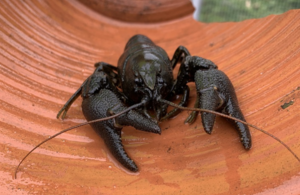Investigations into deaths of native species in Northumberland
The Environment Agency is investigating the deaths of endangered native white clawed crayfish.

An image of a Crayfish.
Around 70 crayfish from the internationally important River Wansbeck population – one of the last remaining strongholds of the species – have been found dead.
Testing has already ruled out the listed disease white spot syndrome virus as well as crayfish plague, and water quality testing has ruled out pollution.
Further testing is being carried out by the Centre for Environment, Fisheries and Aquaculture Science (CEFAS) on crayfish taken from affected locations to understand if an infectious aquatic animal disease has caused the deaths.

An Environment Agency officer surveying for Crayfish.
All evidence presently points to the mortalities only affecting white clawed crayfish. As such, it is unlikely to cause a risk to humans, pets or other wildlife.
People are now being urged to play their part to help limit the spread of any potential infection to currently unaffected areas.
The Environment Agency – supported by other members of the Northumberland Crayfish Partnership – is working to minimise the impact on the crayfish population.
The public and especially river users are being urged to follow advice to prevent any potential infection from spreading across the catchment, and to other nearby catchments such as the Tyne and Blyth, which also have healthy populations of the native species.
Public urged to check, clean, dry
Sarah Jennings, Environment Agency Area Environment Manager, said:
The Wansbeck is such a great home for the white clawed crayfish, which play a really important role in the river’s ecosystem. It’s one of the most abundant populations of the species in Europe, estimated to be in the hundreds of thousands or more.
Everyone has a part to play to limit the spread of any infection which may be affecting them. Advice includes thoroughly cleaning boots and equipment and anything else that has been in or around the river and its tributaries.
If you see any crayfish, alive or dead, leave it where it is and report it immediately to the Environment Agency.
Over the past five years since its launch, the Northumberland Crayfish Partnership, which includes the Environment Agency, Northumberland Rivers Trust, Northumberland Wildlife Trust, Northumberland Zoo and the National Trust, has already done a significant amount of work to safeguard the future of this population.
This includes creating secure breeding areas and safe ‘ark’ sites across Northumberland to support conservation efforts and ensure the crayfish survives into the future.
Field surveys are currently being carried out by Environment Agency officers to understand the extent of the deaths across the catchment.
The Environment Agency is calling on people to play their part by making sure they Check, Clean and Dry to prevent the spread of any infection.
-
Check clothing and equipment for mud, aquatic animals or plant material. Remove anything found and leave it at the site.
-
Clean everything thoroughly as soon as possible, paying attention to areas that are damp or hard to access and using hot water if possible.
-
Dry everything for as long as possible before using elsewhere. Waterbourne diseases can remain on damp footwear and equipment for 48 hours.
Rosie Hails, National Trust Director of Science and Nature said:
We are saddened to hear of the recent deaths of native white clawed crayfish in the River Wansbeck in Northumberland. The river flows through the Wallington estate cared for by the National Trust, where we’ve been undertaking a significant conservation project to protect the species, which has included the creation of two ‘Ark’ sites since 2022.
Whilst we wait to hear the cause of these deaths and the impact on the population, the work that has been undertaken alongside other organisations in the Northumberland Crayfish Partnership has put us in a strong position to react and respond effectively.
We will continue to work closely with the Environment Agency and partners to help limit the spread of infection and safeguard the future of this vital crayfish population. We ask that anyone visiting the Wallington estate follows the CHECK-CLEAN-DRY set of principles if you have been in water.
More information on check, clean, dry can be found on the invasive non-native species website.
If people see any crayfish, alive or dead, leave it where it is and report it immediately to the Environment Agency on 0800 807060.
It is illegal to handle or remove crayfish from the water without the correct licences.